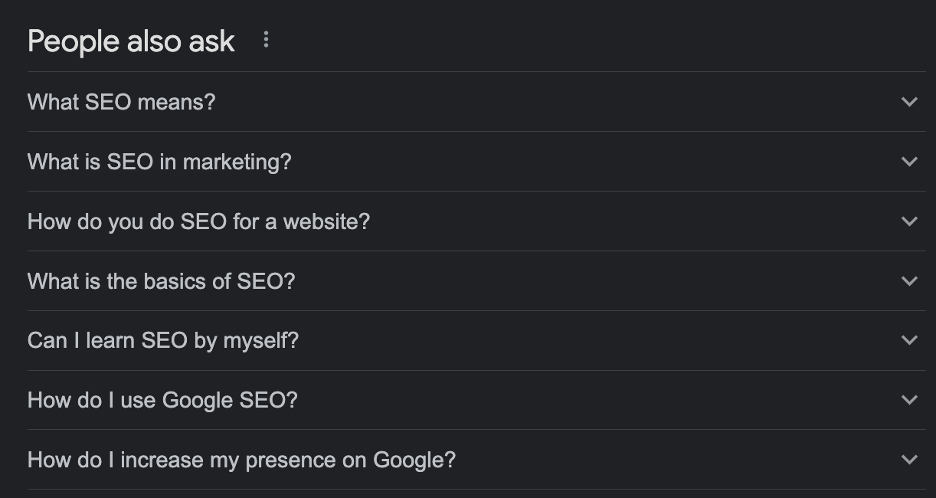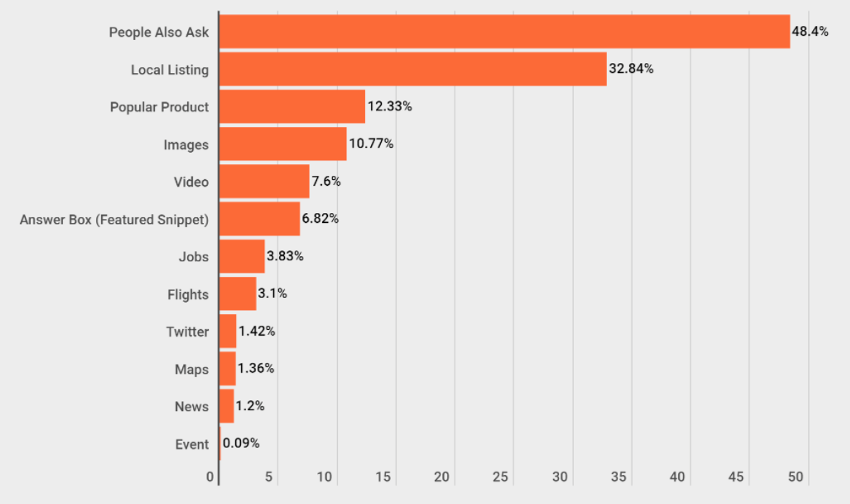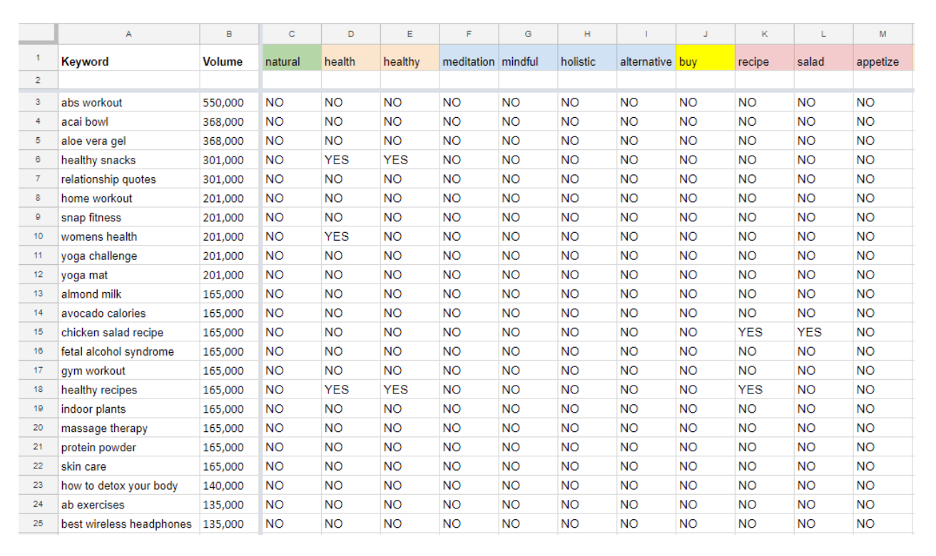
SEO, or search engine optimization, improves a website’s organic ranking through increased relevance, trustworthiness, and usability by optimizing a website’s technical configuration, content relevance, and link popularity. This digital marketing strategy drastically increases incoming traffic by making the site more easily findable and popular to appear on the first pages of Google, Bing, or any other search engine. It is a closed loop system because as SEO is improved, the site will receive more web traffic which in turn will further boost the site’s SEO. Search engine optimization is crucial for any online business as 95% of people never make it past the first page of a search result.
What is SEO?
Search engines like Google use over 200 factors to generate and order search results based on their latest algorithm. By optimizing your content and code, SEO takes these factors into consideration to rank your site at the top of the search results.
Here are some surprising stats for SEO in 2022:
- Video content is 50 times more likely to drive organic search traffic than plain text
- 72% of marketers describe content creation as their most effective SEO tactic
- Companies who blog get 97% more links to their website and 434% more indexed pages
- The top-ranking blog posts have 2,000-2,500 words
- Using real photos instead of stock photos can increase conversions by 35%
- Articles with images get 94% more views
In addition to adding a blog or video and images, here are the other fundamental ways to improve your website’s SEO.
Responsive design
A responsive and dynamically designed website that adapts to any device (tablet, phone, laptop) is paramount for ranking on the front page. If your website is not mobile-friendly, it will fail categories related to usability and accessibility. Check out Google’s Mobile-Friendly Tool to see if your website passes the test.
Page speed
If the speed of your site is not fast enough, it could jeopardize your number one spot in the rankings. Check your website’s performance and speed for free with Google’s PageSpeed Insights Tool.
Links
Having trusted and authoritative websites link to yours through either backlinks or internal links will let Google know that your website offers valuable content that should be shown to more users. Web crawlers (digital bots) find and index pages through discoverable links so that new and updated websites show up for future related keyword and phrase search results. Through the use of internal links, crawlers can understand the context and relationship between different pages on your site. You can request for Google to crawl and index your site by signing up with a Google Search Console account.
On-page optimization
On-page optimization includes several different essential ranking factors such as keyword use throughout content, headers, and title tags, content originality and usefulness, and optimizing images.
Accessible website
In order for search engines to crawl and index your site, it must be accessible via a robots.txt file and sitemap, which can be checked for free via Google’s Search Console. Having an accessible site also means that is it easy and intuitive for your users to use, further improving your SEO by reducing bounce rates.
How Long Does SEO Take to Work?
Search engine optimization generates long-lasting organic search traffic to your site, but the results are not instantaneous. Domains registered for over a year appear more credible, so if your site is new and you have already followed these SEO guidelines, it may just be a matter of waiting. Over 60% of sites in the top ten Google search ranking are three years old or more. While there is no set timeline for SEO to work, you should be seeing substantial results by the six-month mark.
The first three months
During the first three months of optimization, it will be expected to see a noticeable increase in SERP (Search Engine Results Pages) position but nothing major. Unlike pay-per-click Google ads that have immediate results, SEO takes a bit more time and is an on-going process but is worth the added efforts (in the end, the tortoise does win the race). With SEO comes the advantage of long-lasting and reliable organic results without having to pay for direct advertising. Also, users are less trusting of paid advertisements so the added trustworthiness that an organic search can bring is truly priceless.
Months three to six
This is a crucial time period because if you do not see results by month six, you will need to re-evaluate your strategy on targeted keywords. It should be noted though that SEO is typically measured year over year, so do not get discouraged if you are not ranking as high as you would like to be just yet.
Months six and beyond
Once you’ve crossed the six-month milestone, growth should be building consistently. By one year, you should be reaping the rewards of organic traffic through your hard efforts.
Top 10 SEO Trends and Strategies in 2022
Although the basic principles of SEO remain the same every year, the algorithm is constantly evolving based on user’s behavior and developing search trends. Below are the top 10 SEO trends and strategies to look out for in 2022 and stay up to date in this competitive online landscape.
Core Web Vitals optimization
Investing in improving your website’s Core Web Vitals through the hiring of a skilled web developer will have the largest impact in improving your SEO. The user’s page experience, or Core Web Vitals, is categorized by the following performance metrics:
- Largest Contentful Paint (LCP): length of time for the largest content asset to load
- First Input Delay (FID): how long it takes for the site to respond to a user’s first interaction
- Cumulative Layout Shift (CLS): number of unexpected layout shifts during the lifespan of a page
“People also ask” long-tailed keywords

Figure 1: People also ask Google feature
A recent study of 2.5 million search queries showed that Google’s “People also ask” (PAA) shows up for 48% of all searches. This feature provides the answers to the most commonly asked questions by millions of people every day. By providing directed responses to these popular questions, your site has a higher chance of making it this outstanding placement at the top of the SERP.

Figure 2: Most popular Google search features [6]
Incorporate long-tail keywords (longer and more specific keyword phrases, indicative of the long-tail shape graph seen below) to target visitors who are more likely to be closer to a point-of-purchase as opposed to a generic search. Despite these keywords having a smaller search volume, using specific and detailed keywords will greatly increase your conversions without having to fight megalithic competition over short keywords. (Less competition also translates to a lower cost per click).

Figure 3: Long-tail keywords graph showing search distribution [9]
70% of page views are a direct result of long-tailed keywords, closely emanating the famous 80/20 rule where 20% of your efforts will result in 80% of your rewards/profits.
Keyword clustering
To grow organic traffic, you must think of SEO in terms of “product/market fit” with keyword research as the market and your content being the market. The fit is then SEO. By planning your content around what users are currently searching for, your traffic will be guaranteed to increase.

Figure 4: Product/market fit of SEO [8]
Keyword research is the backbone of SEO. Google ranks pages not only based on one keyword but multiple, so the keyword strategy has gotten more complex with what is known as keyword clustering. Keyword clusters are groups of keywords that belong to similar searches. Why only target one keyword per article when you can target twenty?
Here are some keyword research tools that you can use to research top-ranking keywords. For more in-depth research, collect keywords from a few different sources such as your competitors, your existing Google Analytics data, Google’s autocomplete suggestions, and brainstorming your own ideas. Aim to make a list of at least 1,000 keywords to find correlated patterns in and choose from. Here is a free Word and Phrase Frequency Counter to find the most used keywords within your combined list. The more words in a phrase, the better, so give these long-tailed keywords a higher weighted rank. Shorten your list of phrase keywords down to around 50. Then choose the top 10 to 20 single keywords that best represent your business. Create a matrix of phrase keywords and single keywords to identify if the short keyword stems from the longer phrase with a YES or NO using the following formula for each column (example shown for column D):
=IF(RegExMatch(A5,”health”),”YES”,”NO”)

Figure 5: Keyword research matrix [8]
Take the YES results for the long phrase keywords and create separate Excel tabs for each of these. Each tab will be a separate keyword grouping. Add other relevant long-tailed keywords that include the same word to create your keyword cluster to use in an optimized piece of content. This is also a great starting point to plan out a future content calendar tailored to your target audience or to update existing content (such as previous titles or headers) to best match your findings.
AI-generated content
While it is not advised to generate all of your content with robots (they do not know whether what they are writing makes sense, is offensive, fake, sounds strange or rather not like a human). Still there are some beneficial uses for artificial intelligence (AI) such as creating the:
- Title
- Topic brainstorming
- Meta tags
- Outlines or first drafts
OpenAI released the machine learning model and text generator GPT-3 (third-generation Generative Pre-trained Transformer) last year in 2021, the largest natural language processing (NLP) model ever. This leap in innovation has birthed many other tools such as SearchAtlas, Copysmith, Jasper, CopyAi, and Headlime.
Content optimization software
Content optimization tools use similar NLP algorithms as Google to find keywords, synonyms, subtopics, and common questions that search engine crawlers are looking for.
Schema markup rich snippets
Add rich snippets with Schema markup to extract attractive, useful, and clickable content from your site to a Google search. Adding Schema markup to your website will:
- Increase CTR by 17%
- Raise brand awareness and recognition at the top of search results
- Improve targeting
- Get a CTA from Google such as “Call” or “Get Now”

Figure 6: Rich snippet example [10]
High-quality long-form content
There is a strong correlation between length of content and high Google rankings since longer content is associated with E-A-T (expertise, authoritativeness, and trustworthiness). Aim to have articles with at least 2,000 words to rank in the top 10 of search results and be sure to include comprehensive information on your keywords, cite everything, include links, provide original content, and most importantly make sure it is quality work.

Figure 7: Average blog post length of top 10 ranking sites [5]
Tried-and-true SEO
The concepts of SEO roughly remain the same each year, despite the algorithm constantly getting updated. Stick to these basics to ensure your website’s success:
- Content quality: Write accurate, current, original, and in-depth articles on relevant keywords.
- On-page SEO: Optimize meta titles and descriptions, header tags, images, and body text.
- Backlinks: Get high-quality backlinks from other sites through guest blogging, content marketing, and public relations.
- Technical SEO: Hire an experienced web developer to create fast-loading, responsive, properly indexed, and high-quality UI/UX.
New democratization of search
Since Google is getting much better at finding quality pages, the role of authority in E-A-T will become less significant for ranking. Search is thus becoming more democratic, allowing newer and less trafficked web pages to reach the top of the ranks with quality content.
New and up-and-coming search engines
With over 70% of the search market share, Google will mostly likely be the top search engine for years to come. Although as NLP technologies improve, search competitors like DuckDuckGo and Ecosia may quickly rise in important and relevance so be sure to include others in your SEO strategy.
HD Digital Design is Here to SEO Optimize Your Site!
Here at HD Digital Design, we custom develop and design your WordPress site with all of these SEO best practices in mind. The sites we create are professional, responsive, and built on a strong foundation with search engine optimized code so that your website ranks. Contact us today for a free quote and 20-minute Discovery Call to discuss your vision for your business and website!
References
[1] https://www.logicalposition.com/blog/how-long-does-it-take-for-seo-to-work
[2] https://www.webfx.com/seo/learn/how-seo-works/
[3] https://www.webfx.com/blog/seo/meta-tags/
[4] https://optinmonster.com/seo-ranking-factors/
[5] https://www.wordstream.com/blog/ws/2022/01/25/seo-trends
[6] https://www.digitalinformationworld.com/2021/08/data-shows-people-also-ask-and-local.html
[7] https://www.wordstream.com/blog/ws/2013/09/18/best-keyword-research-tools
[8] https://moz.com/blog/the-advanced-guide-to-keyword-clustering
[9] https://www.wordstream.com/long-tail-keywords
[10] https://www.wordstream.com/blog/ws/2021/09/15/what-is-schema-markup
